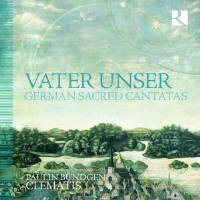Texte paru dans: / Appeared in: |
|
|
Reviewer: James
A. Altena
This CD presents 14 works,
mostly drawn from the famed Düben manuscript collection in Uppsala, Sweden,
that (with the exception of an anonymous instrumental sonata) were composed
for use in the Lutheran liturgies in the 17th century. Eight of the 14
featured works (Tunder has two pieces included) are sacred cantatas for solo
voice with instrumental accompaniment; the other six are instrumental pieces
composed for meditative interludes. Several of the composers included here
were in the orbit of Heinrich Schütz: David Pohle (1624–1695) and Johann
Theile (1646–1724) were pupils, Johan Hermann Schein (1586–1630) was an
extremely close friend (Schütz traveled to be present at his deathbed), and
Johann Rudolph Ahle (1625–1673) and Franz Tunder (1614–1667) were friends
and junior colleagues. Of the others, Johannes Eccard (1553–1611)—the
booklet’s table of contents mistakenly gives his first name as “Samuel” but
it is correct elsewhere—was a chief pioneer of Lutheran service music who
worked as a conductor in the ducal chapel at Königsberg from 1583 to 1608
and then at the elector’s chapel in Berlin for his last three years.
Heinrich Schwemmer (1621–1696) was a South German pedagogue who made his
career in Nuremberg in 1641 until his death; his pupils included Johann
Krieger and Johann Pachelbel. The two Bach brothers I have discussed before
in a review of a set of their combined complete organ works, and of course
Georg Böhm was J. S. Bach’s teacher for two years. A bit farther afield
stylistically were Johann Wolfgang Franck (1644–c. 1710) and Johann Fischer
(1646–1716), who were early proponents of German songs and operas. Franck
had the dubious distinction of being forced in 1679 to flee his position in
Ansbach for Hamburg (whence he later relocated to London in 1690) after
murdering a chapel musician and wounding his own wife in a fit of jealous
rage. He was succeeded in his Ansbach position by Fischer, who had
previously labored in Augsburg, Paris (where he served five years as a
scribe for Lully), and Stuttgart. Highly peripatetic (in part due to being
an avid fisherman always seeking new locales for his avocation), Fischer
would thence meander on to positions in Jelgava and Riga in modern-day
Latvia, Lüneberg, Schwerin, and Brandenburg, with interim stays in
All of this music is quite lovely, with performances to match. The ensemble Clematis is 11 members strong here, with nine players on instruments of the Baroque violin family and the other two playing the organ and the recorder and bassoon. Its string players produce a ravishingly rich and yet silvery tone, close in timbre to a viol consort, and the other two members integrate ably with them. Countertenor Paulin Bündgen has a beautiful voice, a degree plummier in sound than Andreas Scholl but not as incisive in his delivery of text, though he certainly is quite expressive in his own right. The recorded sound has enfolding warmth without turning spongy. A trilingual German-French-English book, housed in a digipak case pocket, provides detailed notes and full texts. While we are now blessed with a plethora of excellent discs of Baroque sacred music, this is one that I find especially satisfying; enthusiastically recommended. | |
|
|
|
|
|
|
|
Cliquez l'un ou l'autre
bouton pour découvrir bien d'autres critiques de CD |
|




